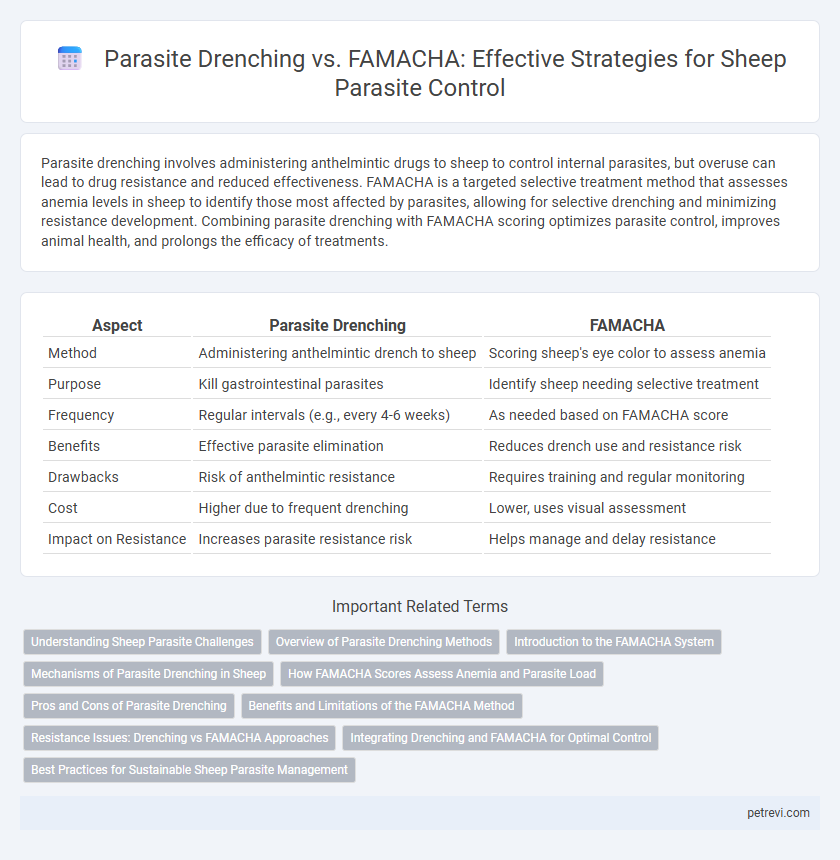Parasite drenching involves administering anthelmintic drugs to sheep to control internal parasites, but overuse can lead to drug resistance and reduced effectiveness. FAMACHA is a targeted selective treatment method that assesses anemia levels in sheep to identify those most affected by parasites, allowing for selective drenching and minimizing resistance development. Combining parasite drenching with FAMACHA scoring optimizes parasite control, improves animal health, and prolongs the efficacy of treatments.
Table of Comparison
| Aspect | Parasite Drenching | FAMACHA |
|---|---|---|
| Method | Administering anthelmintic drench to sheep | Scoring sheep's eye color to assess anemia |
| Purpose | Kill gastrointestinal parasites | Identify sheep needing selective treatment |
| Frequency | Regular intervals (e.g., every 4-6 weeks) | As needed based on FAMACHA score |
| Benefits | Effective parasite elimination | Reduces drench use and resistance risk |
| Drawbacks | Risk of anthelmintic resistance | Requires training and regular monitoring |
| Cost | Higher due to frequent drenching | Lower, uses visual assessment |
| Impact on Resistance | Increases parasite resistance risk | Helps manage and delay resistance |
Understanding Sheep Parasite Challenges
Effective sheep parasite control requires addressing the growing resistance of gastrointestinal nematodes to traditional drenching methods, which can lead to reduced efficacy and increased parasite burdens. The FAMACHA system provides a targeted approach by monitoring anaemia levels in sheep, allowing selective treatment based on individual parasite loads, thereby slowing resistance development. Integrating parasite drenching with FAMACHA assessments optimizes parasite management by balancing effective control and sustainable drug use.
Overview of Parasite Drenching Methods
Parasite drenching methods for sheep primarily involve administering anthelmintic treatments orally to target internal parasites such as gastrointestinal nematodes. Common drenching techniques include using calibrated drench guns to ensure accurate dosage based on sheep weight, minimizing under-dosing that can lead to drug resistance. Regular strategic drenching protocols combined with pasture management significantly reduce parasite burdens and improve flock health.
Introduction to the FAMACHA System
The FAMACHA system is a targeted selective treatment method designed to reduce parasite resistance by identifying sheep suffering from anemia caused by Haemonchus contortus, a prevalent gastrointestinal parasite. This method involves scoring the color of the sheep's eyelid mucous membrane on a scale from 1 (healthy) to 5 (severely anemic) to determine the need for drenching. By using FAMACHA, farmers can minimize the frequency of anthelmintic treatments, preserving the efficacy of parasite drenches and promoting sustainable parasite management.
Mechanisms of Parasite Drenching in Sheep
Parasite drenching in sheep involves administering anthelmintic chemicals that target gastrointestinal nematodes by disrupting their metabolic processes or neuromuscular function, leading to parasite paralysis or death. Common classes of drenches include benzimidazoles, macrocyclic lactones, and imidazothiazoles, each acting on specific parasite receptors or enzymes to eradicate infestations. Effective drenching reduces parasite burden, improves sheep health and productivity, and helps manage anthelmintic resistance when integrated with targeted treatment strategies.
How FAMACHA Scores Assess Anemia and Parasite Load
FAMACHA scoring assesses anemia in sheep by evaluating the color of the mucous membranes, directly correlating paleness to blood loss caused by Haemonchus contortus parasites. This targeted method helps identify individual animals with high parasite loads, enabling selective drenching and reducing the risk of anthelmintic resistance compared to routine parasite drenching. Regular FAMACHA assessments improve parasite control efficiency by focusing treatment on sheep exhibiting early signs of clinical parasitism.
Pros and Cons of Parasite Drenching
Parasite drenching in sheep offers a rapid and effective method to reduce internal parasite loads, helping to maintain flock health and productivity. However, frequent use can lead to anthelmintic resistance, diminishing drug efficacy over time and necessitating higher treatment doses or alternative medications. Cost and labor intensity also increase with routine drenching, making strategic parasite management essential for sustainable sheep farming.
Benefits and Limitations of the FAMACHA Method
FAMACHA is a targeted selective treatment method that reduces parasite drenching frequency by identifying sheep with anemia caused by Haemonchus contortus through evaluating eyelid color, optimizing parasite control and minimizing anthelmintic resistance. Benefits include preserving refugia populations to delay resistance development and reducing chemical usage, while limitations involve the need for regular training, accurate scoring, and its effectiveness primarily against Haemonchus species rather than a broad spectrum of gastrointestinal parasites. The method's success depends on consistent monitoring, appropriate implementation, and integration with other parasite management strategies for sustainable flock health.
Resistance Issues: Drenching vs FAMACHA Approaches
Parasite drenching in sheep, while effective at reducing worm burdens, has led to widespread anthelmintic resistance due to repeated and sometimes unnecessary treatments. In contrast, the FAMACHA system targets only animals showing anemia symptoms caused by Haemonchus contortus, reducing drench frequency and slowing resistance development. Integrating FAMACHA scoring with strategic drenching enhances sustainable parasite control and preserves anthelmintic efficacy.
Integrating Drenching and FAMACHA for Optimal Control
Integrating parasite drenching with the FAMACHA system enhances sheep parasite control by targeting anthelmintic treatments to individuals showing anemia symptoms, reducing drench resistance. FAMACHA scoring identifies sheep with high parasite burdens, allowing selective drenching that minimizes chemical use and preserves effective anthelmintics. Combining these methods improves flock health, slows resistance development, and promotes sustainable parasite management.
Best Practices for Sustainable Sheep Parasite Management
Effective sheep parasite management requires balancing parasite drenching with FAMACHA scoring to reduce anthelmintic resistance and maintain flock health. FAMACHA allows targeted selective treatment by assessing anemia levels caused by Haemonchus contortus, promoting sustainable use of dewormers. Integrating regular fecal egg counts and pasture rotation complements these practices, optimizing parasite control while preserving drug efficacy.
Parasite Drenching vs FAMACHA for Sheep Parasite Control Infographic

 petrevi.com
petrevi.com